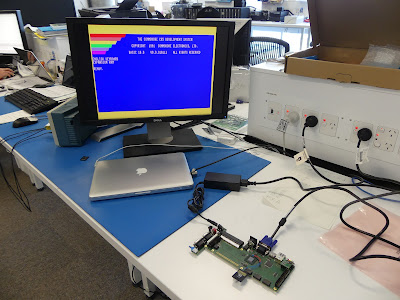After getting the MEGA65 prototype PCB up and running last night, today was time to build up the prototype in the lab.
Second, make sure that it boots fine:
Third, get my Commodore 65 keyboard that I bought ages back on ebay, and one of the plastic laser-cut outlines I made when I was starting to work on the laptop concept for the MEGA65:
Work out how I was going to hold it in place. There are three hole-throughs on the keyboard:
Looking closer at one of them:
Unfortunately, one of them is behind the space bar (which is possibly the widest space bar I have ever seen on a keyboard -- a point which is causing us some fun in getting our own production in order for our own MEGA65 keyboards.) So I resorted to drilling some holes in my acrylic outside, and screwing a retainer strip on the back. It isn't perfect, but it works enough for now:
You can also see that I have screwed the C65 prototype motherboard down to another panel, and then added a home-made friction hinge (although it isn't strong enough to hold the keyboard open in position), so that I can open it up to get to the SD card. We might yet extend the SD card to a better location, so that we don't need to open the "lid" all the time.
Putting it altogether and powering it up, it still looks very, very rough -- but the point is we now have a working and usable bench-top prototype, from which to progress.
And looking in the side, where you can really see that the temporary physical construction is indeed a gross hack.
So, now I have it working. One of the really unexpected things was a wave of emotion and nostalgia as I started interacting with a C65 via a real feeling keyboard for the first time in close to ten years. I didn't get this when using a keyrah and Commodore 64 keyboard on it, and certainly not using a USB PC keyboard.
But suddenly with a real C65 keyboard, it felt like I was 19 again, and using the prototype C65 again. It's hard to explain. It might be the tactile feel of the keyboard, or even the subtle timing of where in the key press the computer registers the input, or some combination of the two. But whatever the trigger, it was like smelling a familiar smell for the first time in years, and having that rush of memory and recollection, including evoking the emotion of the moment, not just the cerebral memory of it.
It is this thrill and experience that I hope we can share as we continue with making new C65s through the MEGA65 project. That wonder of discovering a new heir in a noble lineage of computers. We might not be Commodore, but I am convinced that we will be able to bring the C65 to completion, and finally bring the last chapter of the 8-bit dynasty to life.

















